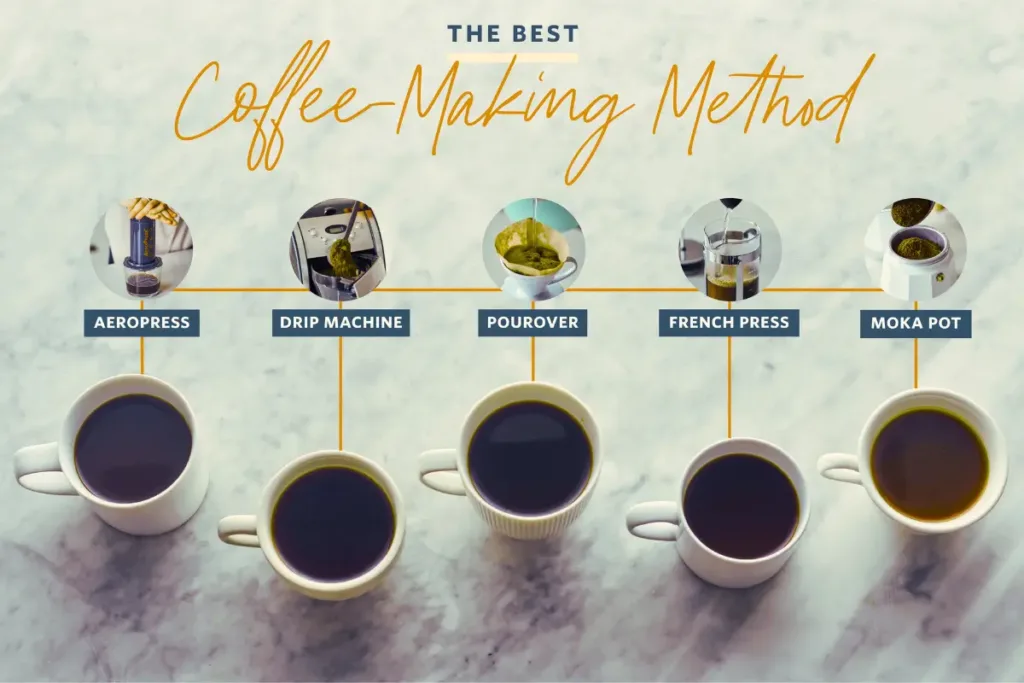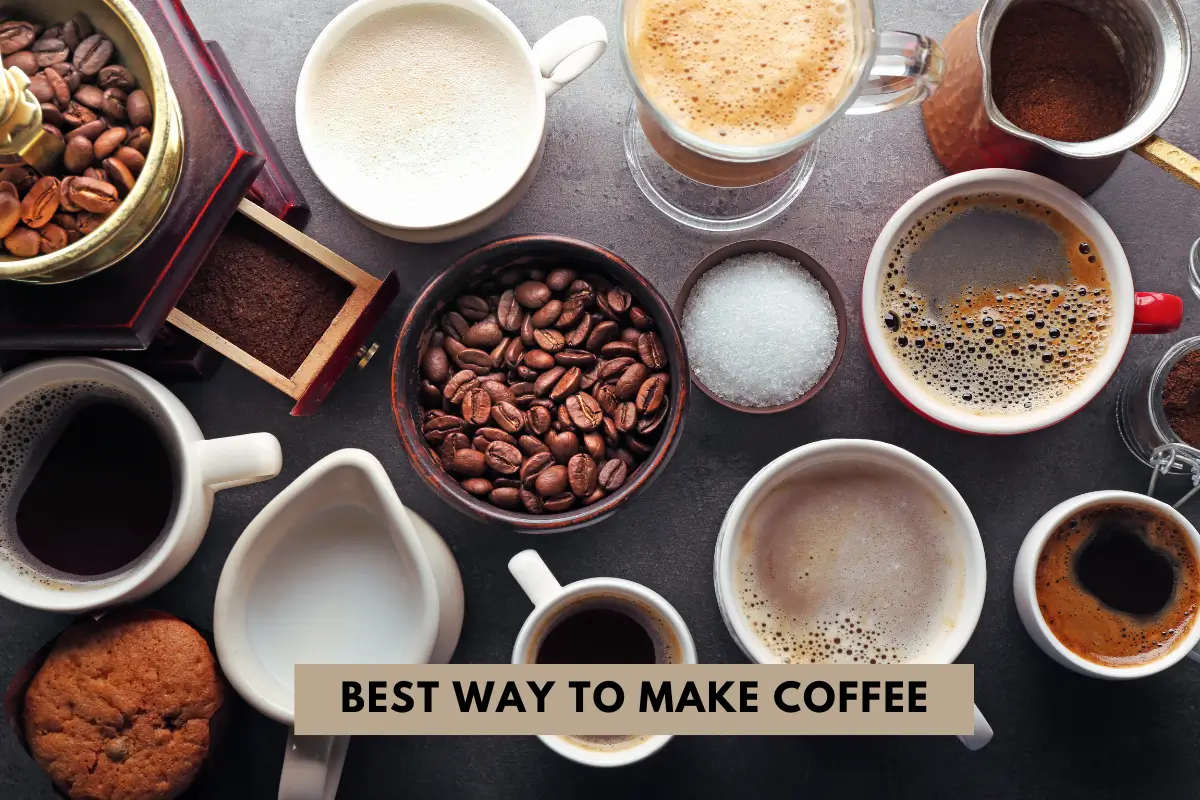Coffee is more than just a beverage; it’s a morning ritual for many. Discovering the best way to make coffee can transform your daily routine.
For many people, starting the day with a perfect cup of coffee is essential. The process of making coffee can be simple or complex, depending on your preferences and the equipment you use. From traditional drip coffee makers to modern espresso machines, each method offers a unique taste experience.
Understanding the different ways to brew coffee can help you find the best method that suits your taste and lifestyle. Whether you’re a coffee novice or an experienced barista, exploring various brewing techniques can elevate your coffee-making skills.
Dive into the world of coffee and discover how to make the perfect cup that will kickstart your day.
Introduction To Perfect Coffee
Discovering the best way to make coffee can transform your daily routine. Learn the secrets of brewing a perfect cup. Enjoy a rich, flavorful experience every morning.
Introduction to Perfect Coffee: A perfect cup of coffee can transform your morning. It’s not just about the caffeine kick; it’s about the rich flavors and aromas that make each sip an experience. But how do you achieve that perfection?
Importance of Quality Coffee: Quality coffee beans are the foundation of a great brew. They can make or break your coffee experience. Opt for freshly roasted beans to ensure maximum flavor. Look for beans from reputable sources. Single-origin beans often have distinctive flavors that can elevate your coffee. Consider the roast level. Light, medium, or dark roast can drastically change the taste of your coffee. Find what suits your palate.
Expert Insights: Coffee experts emphasize the importance of grind size. A coarse grind works best for the French press, while a fine grind is ideal for espresso. Water quality also matters. Use filtered water to avoid any unwanted flavors in your coffee. Brewing time and temperature are crucial.
Too hot or too cold, and you can ruin your coffee. Aim for a balanced extraction time for optimal flavor. Have you ever wondered why your coffee tastes different at home compared to a café? It often boils down to the precision and care taken in each step of the brewing process.
Conclusion: Perfect coffee is achievable with the right beans, grind size, water quality, and brewing method. Paying attention to these details can make all the difference. So, next time you make coffee, think about each step and enjoy the process.
Choosing The Right Beans
Choosing the right beans is the first step to brewing the perfect cup of coffee. The right beans can make all the difference in your morning ritual. Let’s dive into the various types of coffee beans and their roast levels to help you make the best choice for your taste buds.
Types Of Coffee Beans
There are four main types of coffee beans: Arabica, Robusta, Liberica, and Excelsa. Each type has unique flavors and characteristics.
Arabica beans are the most popular and are known for their smooth, sweet taste with hints of fruit and sugar. They are less acidic and have a higher concentration of sugars.
Robusta beans are stronger and more bitter, with a nutty aftertaste. They have higher caffeine content, which gives you that extra kick.
Liberica beans offer a smoky, almost woody flavor. These beans are less common but add a unique twist to your coffee experience.
Excelsa beans are often used in blends to add complexity and depth. They have a tart, fruity flavor that stands out in a mix.
Have you ever tried a blend of Arabica and Robusta? Combining these can give you a balanced cup that’s both smooth and strong.
Roast Levels
Roast levels also play a crucial role in the flavor of your coffee. The three main roast levels are light, medium, and dark.
Light roast beans are light brown in color and have a more acidic taste. They retain most of the original flavors of the bean, making them ideal for tasting the unique qualities of different coffee beans.
Medium roast beans are balanced with a richer flavor and less acidity. They are the most popular choice, offering a good middle ground for most coffee drinkers.
Dark roast beans are dark brown to almost black. They have a bold, smoky flavor with less acidity. Dark roast beans are perfect if you prefer a strong, robust cup of coffee.
Have you noticed how your choice of roast changes the entire coffee experience? Give different roast levels a try to find your perfect match.
Now that you know about the types of beans and roast levels, it’s time to experiment. Buy small batches and try different combinations. You might find a new favorite that transforms your morning brew.
Grinding Coffee Beans
Grinding coffee beans is an essential step in brewing the perfect cup of coffee. The grind size and consistency directly affect the flavor and strength of your coffee. Let’s explore the importance of grind size and the various grinding methods.
Grind Size And Consistency
Choosing the right grind size is crucial. Different brewing methods require different grind sizes. For example, espresso needs a fine grind, while French press requires a coarse grind. Grind consistency ensures even extraction. Uneven grinds can lead to bitter or weak coffee.
Investing in a good grinder can make a big difference. Burr grinders offer more consistent results than blade grinders. Consistency in grind size leads to better-tasting coffee.
Grinding Methods
There are several ways to grind coffee beans. Blade grinders are affordable and easy to use. They chop the beans, but the grind can be uneven. Burr grinders crush the beans between two surfaces, providing a uniform grind.
Manual grinders are another option. They require more effort but give control over the grind size. Electric grinders are convenient and fast. They are ideal for busy mornings.
Each method has its pros and cons. Choose the one that fits your needs and budget. Grinding your own beans ensures freshness and enhances flavor.
Water Quality And Temperature
When it comes to making the perfect cup of coffee, water quality and temperature play a crucial role. They can significantly influence the flavor and aroma of your brew. Let’s explore how to optimize these elements for the best coffee experience.
Optimal Water Quality
Good coffee starts with good water. Tap water can vary in quality, so it’s essential to use clean, filtered water. This removes impurities and ensures a smoother taste.
Avoid using distilled or softened water. These types of water can strip away essential minerals that enhance the coffee’s flavor. Instead, opt for bottled spring water if your tap water is too hard or chlorinated.
Have you ever noticed a metallic taste in your coffee? That could be due to the water quality. Using a simple water filter can make a world of difference.
Ideal Brewing Temperature
Temperature control is another key factor in brewing excellent coffee. The optimal brewing temperature ranges between 195°F to 205°F (90°C to 96°C). This range extracts the right balance of flavors from the coffee grounds.
Boiling water (212°F or 100°C) can burn the coffee, leading to a bitter taste. On the other hand, water that’s too cool won’t extract enough flavor, resulting in a weak brew.
Use a thermometer to measure the water temperature. If you don’t have one, let the boiling water sit for about 30 seconds before pouring it over your coffee grounds. This cooling period usually brings the water to the right temperature.
Have you tried experimenting with different temperatures? Notice how slight adjustments can make your coffee taste better or worse. It’s a small detail, but it can change your entire coffee experience.
Next time you brew, think about your water quality and temperature. It’s a simple tweak that can elevate your coffee game. Do you have any tips or tricks for perfecting your coffee? Share them in the comments!
Brewing Methods
Choosing the right brewing method can greatly affect your coffee’s taste. Different techniques can bring out unique flavors and strengths. In this section, we explore two popular methods: drip coffee makers and French presses. Each method has its own set of benefits and drawbacks.
Drip Coffee Maker
A drip coffee maker is a common household appliance. It is easy to use and convenient for making large batches. You start by filling the machine with water.
Then, add ground coffee to the filter basket. Once you press start, the machine heats the water. It then drips through the coffee grounds into a carafe.
Drip coffee makers are consistent. They offer a balanced flavor. The process is automated, so it requires little attention. This method is ideal for busy mornings.
French Press
A French press offers a different experience. It allows you to control the brewing time. To use a French press, add coarse coffee grounds to the pot. Pour hot water over the grounds. Let it steep for about four minutes. Then, press the plunger down slowly. This separates the grounds from the liquid.
The French press delivers a rich and bold flavor. It retains the natural oils of the coffee. This method is perfect for those who enjoy a strong cup of coffee. The process takes a bit more time. But many find the results worth the effort.
Espresso Techniques
Espresso is the heart of many coffee drinks. Mastering espresso techniques can improve your coffee experience. Let’s explore two key elements: pulling the perfect shot and steaming milk.
Pulling The Perfect Shot
Start with fresh, high-quality coffee beans. Grind them to a fine consistency. Place the grounds in the portafilter and tamp them evenly. This ensures even extraction.
Lock the portafilter into the machine. Start the brew process. Aim for an extraction time of 25 to 30 seconds. The result should be a rich, golden-brown shot. It should have a layer of crema on top.
Steaming Milk
Use cold milk for best results. Pour the milk into a metal pitcher. Place the steam wand just below the milk’s surface. Turn on the steam to create microfoam.
Lower the pitcher slowly as the milk expands. Keep the steam wand at an angle. This helps create a smooth texture. Heat the milk to about 150°F (65°C). Avoid overheating to prevent a burnt taste.
Pour-over Coffee
Pour-over coffee has become a favorite among coffee enthusiasts for its simplicity and the control it offers over the brewing process. This method allows you to extract rich flavors from the coffee grounds, giving you a more personalized cup of coffee. But how do you make the perfect pour-over coffee? Let’s dive into the equipment you need and the brewing process.
Pour-over Equipment
The right equipment is crucial for making pour-over coffee. You’ll need a pour-over dripper, a kettle, a filter, a coffee grinder, and a scale.
Choose a dripper that suits your style. Popular options include the Hario V60 and the Chemex. Each has its unique design and impact on the coffee’s taste.
A gooseneck kettle is ideal for pouring hot water with precision. This helps in evenly saturating the coffee grounds.
Use a good-quality paper filter to trap coffee grounds and oils. Make sure it fits your dripper perfectly.
Freshly ground coffee beans are a must. A burr grinder is preferred over a blade grinder for consistent grind size.
Lastly, a digital scale ensures you use the right amount of coffee and water. Precision matters in pour-over coffee.
Brewing Process
Start by heating water to about 200°F (93°C). It’s the optimal temperature for extracting flavors without burning the coffee.
Place the filter in the dripper and rinse it with hot water. This removes any paper taste and preheats the dripper.
Weigh out your coffee beans. A common ratio is 1:15 (1 gram of coffee to 15 grams of water). Adjust this based on your taste preference.
Grind the beans to a medium-coarse consistency. It should resemble sea salt.
Add the ground coffee to the dripper and place it over your cup or carafe. Make a small well in the center of the grounds.
Start pouring water slowly in a circular motion, beginning from the center and moving outward. Pour just enough to saturate the grounds and let it bloom for 30 seconds.
Continue pouring water in stages, maintaining a steady flow. Avoid pouring directly on the filter to prevent channeling.
The entire brewing process should take about 3-4 minutes. Adjust your grind size or pour rate if it takes significantly more or less time.
Once the dripping stops, your pour-over coffee is ready. Savor the aroma and enjoy the nuanced flavors.
Do you have a favorite coffee bean or a special technique that makes your pour-over coffee unique? Share your thoughts in the comments below!
Cold Brew Coffee
Cold Brew Coffee has taken the coffee world by storm. It’s a refreshing alternative, especially during the hot summer months. If you’ve ever wondered how to make this smooth and less acidic version of coffee, you’re in the right place.
Cold Brew Basics
Cold brew coffee is made by steeping coarse coffee grounds in cold water for an extended period. The result is a coffee concentrate that can be diluted with water or milk. You don’t need any special equipment, just a jar, coffee grounds, and some patience.
One thing you’ll love about cold brew is its versatility. You can drink it black, with milk, or even use it in coffee-based cocktails. It’s perfect for anyone who enjoys a smoother, less acidic coffee experience.
Steeping Time And Ratios
The steeping time and coffee-to-water ratio are crucial for making a good cold brew. Typically, a 1:8 coffee-to-water ratio works well. This means for every cup of coffee grounds, you’ll need eight cups of water.
Let the mixture steep for about 12 to 24 hours. The longer you steep, the stronger the concentrate. If you like a milder flavor, 12 hours should be enough. For a bolder taste, go for the full 24 hours.
After steeping, strain the coffee grounds using a fine mesh sieve or cheesecloth. Now, you have a cold brew concentrate that you can dilute to your liking. If you prefer your coffee stronger, add less water. For a lighter drink, add more.
Have you ever tried cold brew coffee? What’s your favorite way to enjoy it? Share your tips and experiences in the comments below!
Common Coffee Mistakes
Many coffee lovers make simple mistakes that affect the taste. Knowing these common mistakes can help you make a better cup of coffee. Here are a few key points to keep in mind.
Over-extraction And Under-extraction
Over-extraction happens when coffee grounds soak for too long. This makes your coffee bitter. The water pulls out too many compounds. Under-extraction is the opposite. The water does not stay long enough. This makes the coffee taste sour. The water does not pull out enough flavors.
Stale Coffee Beans
Fresh beans make the best coffee. Stale beans lose flavor and aroma. Always buy beans in small amounts. Use them within a few weeks. Store them in an airtight container. Keep them away from light and heat. Grind the beans just before brewing. This keeps the flavors intact.
Frequently Asked Questions
What’s The Best Method Of Making Coffee?
The best method is to use a French press. It highlights coffee’s rich flavors. Use coarse grounds and hot water. Brew for four minutes. Enjoy!
What Is The 80/20 Rule For Coffee?
The 80/20 rule for coffee suggests using 80% high-quality beans and 20% lower-quality beans. This balances cost and taste.
How To Make A Perfect Cup of Coffee?
Use fresh coffee beans and grind them. Boil water to 200°F. Brew coffee using a French press or drip method. Serve hot.
Is French Press Better Than Drip Coffee?
French press offers a richer, fuller flavor, while drip coffee provides convenience and consistency. Preference depends on your taste and lifestyle.
Conclusion
Making the perfect coffee is an art and science. Experiment with different methods. Find what suits your taste best. Fresh beans and clean water make a difference. Invest in a good grinder. Pay attention to brewing time and temperature. Enjoy the process and the results.
Share your coffee moments with friends and family. Happy brewing and sipping!



